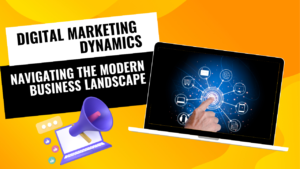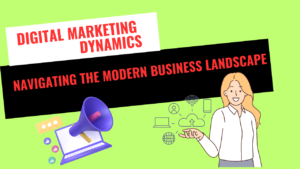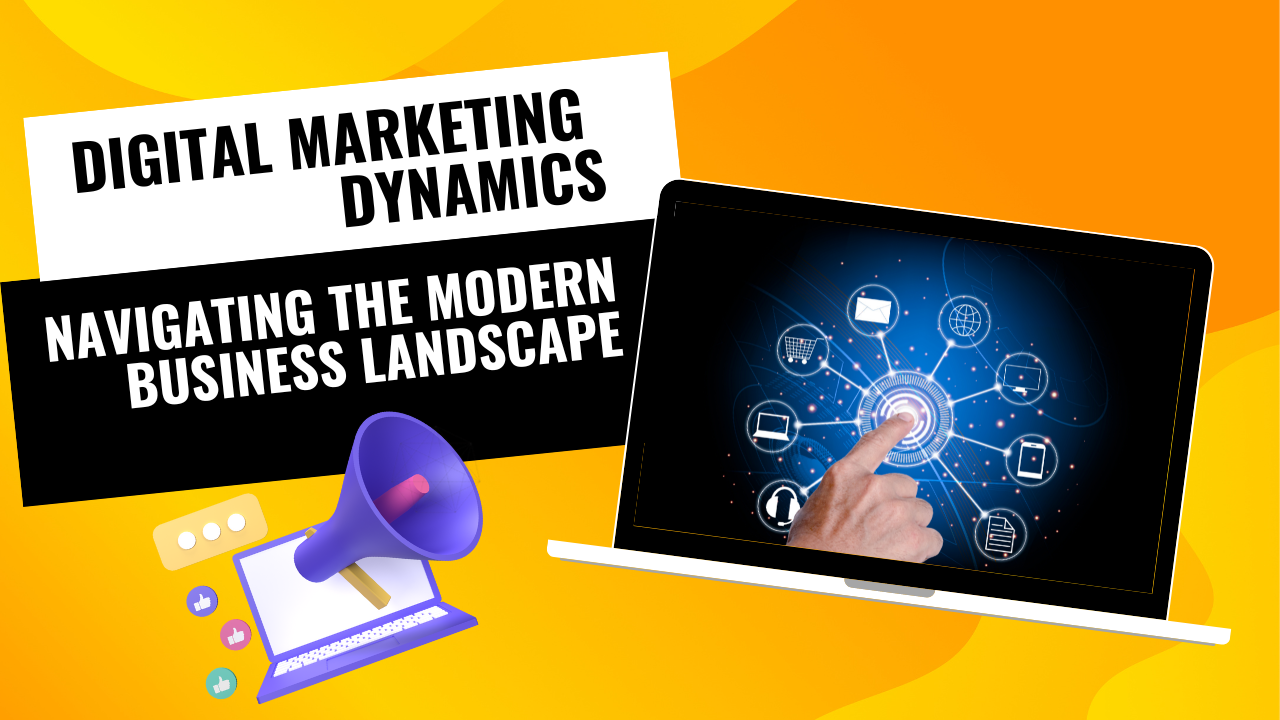Introducing Digital Marketing Dynamics: Navigating the Modern Business Landscape
Introduction:
Businesses are always seeking for fresh and creative ways to engage their audience and keep ahead of the competition in today’s fast-paced, technologically-driven world.Let us introduce digital marketing, a game-changing phenomenon that has completely changed how businesses interact with their clients and advertise their goods. We go into the complexities of digital marketing in this in-depth analysis, looking at its many features, tactics, and significant influence on the contemporary business environment.
1) The Evolution of Digital Marketing:
For you to have an understanding of how essential digital marketing is; you need to understand its origin. Traditional methods of advertising are in the throes of a new paradigm shift embracing digital media for this digital age. A new age of data-centered, versatile, and laser-focused marketing through the internet, social media, and handheld computing.
a) Birth of the Internet Age:
The arrival of internet ushered in new era in marketing. Companies have moved from use of printed papers, television and radio adverts to using more powerful internet platforms like Twitter, Facebook and others. Within no time there existed a global society made possible by World Wide Web which enabled people access to such things as ideas, products, and services, across unparallel ranges.
b) The Social Media Revolution:
These platforms were a huge turning point in internet development; they became powerful instruments used for community formation and communication. The savvy marketers now had their chance to personally address their audience. Recently, social media plays a major role in the digital marketing strategies that allow building ties with many consumers, creating brand loyalty for products, and reaching a bigger market audience.
c) Mobile Dominance:
The rise of smartphones and mobile devices further intensified the shift towards digital marketing. Businesses were able to communicate with customers in real time thanks to mobile applications, flexible websites, and location-based services, resulting in personalized and contextually relevant experiences. Mobile marketing strategies, including SMS campaigns and in-app advertising, became integral components of comprehensive digital marketing plans.

2) Core Components of Digital Marketing:
A wide variety of tactics and channels are included in the broad field of digital marketing. To navigate this complex landscape, businesses need to understand and leverage key components effectively.
a) Search Engine Optimization (SEO):
An essential component of each successful digital marketing plan is an art called scientific optimization. Search engine optimization (SEO) refers to a process whereby certain steps are taken toward making the site page more visible in various web browsers. Therefore, businesses must adopt a search engine optimization foundation in order to create a strong foundation for any business venture.
b) Content Marketing:
The phrase “content is king” echoes across the digital market space. Content marketing refers to generating and posting information that is useful, relevant, and of quality in order to lure as well as keep target customers. Content marketing uses blog posts, articles, infographics, videos, and podcasts as means of establishing authority and gaining customers’ trust leading to action from consumers.
c) Marketing on Social Media:
With over a billion global users, social media offers business tons of ways and channels to interact with their target clients. Social media marketing entails the creation of content for sharing through social networking websites with a view of engaging consumers, promoting the brand and driving more visitors to the website. Marketers can personalize their style for each platform where targeting different groups on their unique traits.
d) PPC (Pay-Per-Click) Marketing:
This has proved to be an advantageous and selective move by companies that have opted for it. With display advertising, for instance, advertisers like Bing Ads and Google ads target keywords and customers looking for identical products/services. However, marketers do not have huge amounts at their disposal and therefore stand to gain more from using pay per click ads since payment is only made upon clicks.
e) Email Marketing:
Contrary to predictions of its demise, email marketing remains a potent tool for engaging with customers. Email campaigns allow businesses to nurture leads, deliver personalized content, and promote products or services directly to a subscriber’s inbox. Automation tools have elevated the efficiency of email marketing, enabling businesses to send targeted messages based on user behavior and preferences.
f) Affiliate Marketing:
Companies use affiliates to promote their products and services in affiliate marketing, and collaboration is vital. Affiliates earn a commission for each sale or lead generated through their marketing efforts, creating a win-win scenario. This performance-based model aligns incentives and allows businesses to expand their reach through a network of affiliates.
3) Techniques for Successful Digital Marketing:
A strategic plan that is in line with business objectives and adaptable enough to change with the digital landscape is necessary for effectively navigating the digital marketing terrain. The following are essential strategies to ensure that digital marketing is successful:
a) Data-Driven Decision Making:
Data has great value in the digital world. Conversion rates, engagement analytics, and user behavior analysis can all be used to get important insights into how successful marketing initiatives are. Businesses should leverage analytics tools to make informed decisions, refine strategies, and optimize performance continually.
b) Personalization:
Consumers today expect personalized experiences. Digital marketing strategies that tailor content, recommendations, and communications to individual preferences are more likely to resonate with audiences. Personalization fosters a sense of connection and relevance, enhancing customer engagement and loyalty.
c) Mobile Optimization:
As mobile usage continues to soar, ensuring a seamless experience across devices is paramount. Mobile optimization involves designing websites, emails, and ads to be responsive and user-friendly on various screen sizes. Mobile-first strategies cater to the preferences of an increasingly mobile-centric audience.
d) Social Listening:
Understanding customer sentiment is crucial in the digital age. Social listening involves monitoring social media channels for mentions, comments, and discussions related to a brand or industry. By actively listening to their audience, businesses can respond promptly, address concerns, and capitalize on opportunities to enhance brand perception.
e) Video Marketing:
Video content has become a dominant force in digital marketing. From explainer videos to live streams, video marketing captures attention and conveys messages effectively. Platforms like YouTube, TikTok, and Instagram offer diverse opportunities for businesses to showcase their products, share stories, and connect with audiences visually.
f) Influencer Marketing:
Collaborating with influencers who resonate with a target audience can amplify a brand’s reach and credibility. Influencer marketing leverages the trust and authenticity influencers have built with their followers, creating a powerful channel for promoting products or services.

4) The Future of Digital Marketing:
Digital marketing landscape is always on the move, and it calls for futuristic thought process. Several trends are shaping digital marketing’s future:
a) Artificial Intelligence (AI) and Machine Learning:
Unveiling Digital Marketing Dynamics is being revolutionized by AI and machine learning through enhancing task automation, offering customized consumer experiences, and anticipating customer behavior. These are examples of AI – driven tools such as chatbots, recommendation engines and predictive analytics that boost productivity and success rates.
b) Voice Search Optimization:
Thanks to virtual assistants like Siri, Alexa or Google assistant voice search becomes increasingly crucial for seo. Given the nature of interactions with voice enabled devices makes use of conversing queries written in natural language and as such optimizing voice search necessitates an emphasis on the same.
c) Augmented and virtual reality (AR/VR):
AR and VR technology provide customers with more engaging experiences. Virtual reality is used by companies in creating virtual showrooms and simulations while augmented reality serves interactivity with product displays. Such innovations would totally transform customer purchasing patterns including the way they relate with brands.
d) Privacy and Data Security:
As concerns about data privacy grow, consumers are becoming more selective about sharing personal information. Digital marketers must prioritize transparent data practices, comply.
Read Also:


Nice information